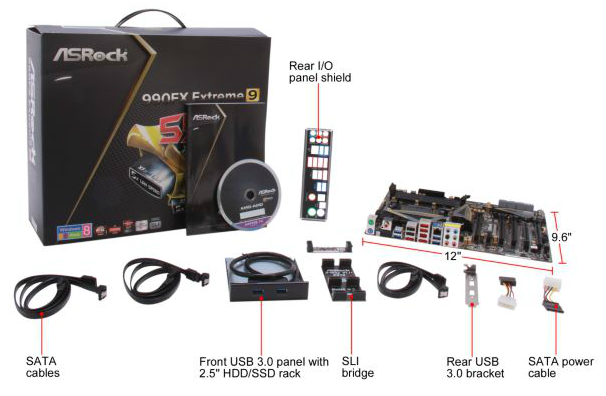AMD’s 5 GHz Turbo CPU in Retail: The FX-9590 and ASRock 990FX Extreme9 Review
by Ian Cutress on August 9, 2014 8:00 AM ESTASRock 990FX Extreme9 In The Box
When I started reviewing motherboards for AnandTech, the motherboard industry was on the verge of USB 3.0 being this new feature, only available through controllers. At the time, due to the difference between USB 2.0 and USB 3.0 headers, cases had not implemented USB 3.0 and the motherboard manufacturers had to add in extra bits and bobs to their motherboards so users could feel the benefit of internal connectors. As time progressed, these extra add-in interfaces migrated into the chassis industry, with most chassis supporting one USB 3.0 header. This relegated any USB 3.0 add-on in the motherboard to those motherboards with two USB 3.0 headers. It is at this point that the 990FX Extreme9 was made, and due to the Extreme9 nomenclature, this bundle is meant to epitomize ASRock’s in-the-box offerings.
In the box we get:
Driver DVD
Manual
Rear Panel Shield
USB 3.0 front panel
Six SATA Cables
Two SLI Cables
The Extreme9 is also one of the last AMD motherboards to support SLI, so the motherboard manufacturers also had to include SLI bridges. I still think the USB 3.0 panel is a good idea for motherboards with two USB 3.0 headers, even today.
ASRock 990FX Extreme9 Overclocking
Experience with ASRock 990FX Extreme9
Overclocking with AM3+ CPUs brought back a small wave of nostalgia. Here we are back at 200 MHz base frequency, and have to deal with 0.5x multipliers. For our testing, we overclocked the FX-8150 CPU similar to our previous 990FX motherboards in order to get consistent data.
Overclocking the 990FX Extreme9 in the BIOS is relatively straightforward, although the level of automatic options in the software is disappointing. We enabled a high load-line calibration, started at 20x200 MHz (4.0 GHz) with 1.200 volts set in the BIOS. Our sample hit 4.6 GHz at 1.325 volts, with +132W power draw over stock.
Methodology:
Our standard overclocking methodology is as follows. We select the automatic overclock options and test for stability with PovRay and OCCT to simulate high-end workloads. These stability tests aim to catch any immediate causes for memory or CPU errors.
For manual overclocks, based on the information gathered from previous testing, starts off at a nominal voltage and CPU multiplier, and the multiplier is increased until the stability tests are failed. The CPU voltage is increased gradually until the stability tests are passed, and the process repeated until the motherboard reduces the multiplier automatically (due to safety protocol) or the CPU temperature reaches a stupidly high level (100ºC+). Our test bed is not in a case, which should push overclocks higher with fresher (cooler) air.
Manual Overclock:
Overclocking on the FX-9590 proved less fruitful. While 5.0 GHz on all cores was stable at stock voltages, at 5.2 GHz temperatures on our setup were already high and caused throttling of the CPU below stock performance levels.












146 Comments
View All Comments
TiGr1982 - Saturday, August 9, 2014 - link
Sorry, DreSden. My fault.SmokingCrop - Saturday, August 9, 2014 - link
lol wat.Here in Belgium, depending on your use, it's about € 0,13 - 0,23 ..
basroil - Sunday, August 10, 2014 - link
Germany is stupid and thinks solar is good for tech industries, Belgium has nuclear plants that give it huge rate discounts. Basically, you can buy this chip in Belgium just fine, but go get an intel chip for germanyDeath666Angel - Sunday, August 10, 2014 - link
You should change your provider. I pay 23c/kWh. Unless you have an "all green" plan, you shouldn't pay that much.KWIE - Wednesday, August 13, 2014 - link
Um, what? Where on earth are you living in Germany to be paying 54c/kWh??? I'm in Dresden and paying 24c/kWh across the board (no HT/NT).Flunk - Saturday, August 9, 2014 - link
Haha, I can think of more important reasons YOU wouldn't want to live in England! You know Gas is more than $8 a Gallon there right? Also, they tax cars based on CO2 generation and cars are almost twice as expensive as they are in the USA!LemmingOverlord - Monday, August 11, 2014 - link
@Flunk, you do understand that is basically the reality for most of the Western world? Gas (Petrol, not gas-gas) is expensive, period. Cars are expensive. Period.Skillztech - Friday, September 12, 2014 - link
Totally unrealistic figures. Yet again intel fans come up with either straight out lies or complete nonsense. "Running this chip at load 24/7 at 18p per kWh for a year" *facepalms*dshk - Saturday, November 22, 2014 - link
HPC and supercomputers are built from Opterons, not from FXs. If you have been playing on your home computer on full load 24/7 then you have bigger problems than paying your electricity bill.Budburnicus - Saturday, January 10, 2015 - link
+1 I feel sad for AMD anymore! This FX can't even compete with a three year old i7-2600K!